Gender equality
Pascale Joannin
-

Available versions :
EN

Pascale Joannin
In December 2013 Angela Merkel was re-elected Chancellor of the Federal Republic of Germany. After this third four year mandate she will have beaten the longevity record of former British Prime Minister, Margaret Thatcher (1979-1990) as the head of one of the most important States in Europe. These two examples show that it is possible for a woman to lead a State but it is still an exceptional situation.
There are few female heads of government. In Europe, apart from Ms Merkel there are three: Helle Thorning-Schmidt in Denmark, Alenka Bratusek in Slovenia and since January, Laimdota Straujuma in Latvia (i.e. 14.2%). If we add Dalia Grybauskaite, President of the Republic of Lithuania we reach a total of five women leaders in the European Union. If we take Europe as a whole there are seven, with the Prime Minister of Norway and the President of Kosovo. Decidedly there are still too few.
However if we look at Europe from an international point of view we can see that it is still the continent in which women enjoy a better status and that they are model for many women around the world. If Europe is to set an example why doesn't it really strike hard in 2014 since the nearly all of the community institutions will be renewed?
For real parity in the European Institutions
Two women in four to lead the institutions to be renewed in 2014
The laws established to support parity over the last few years have enabled a certain rise in the number of women representatives, notably in the European Parliament (36.03%). They chair 8 committees out of 22 (36.36%), including economic and monetary affairs, industry, research and energy. This is quite encouraging but it should not mask the fact that the European Parliament has only been presided over by a woman twice since 1979: 2 in 14 legislatures - 14.2%. This is the same as the percentage of women in the Council.
Will the next Parliament be presided over again by a woman? As it will be the first of the European institutions to be renewed in 2014, if the European Parliament chooses a woman to lead it, we would prevent the grotesque situation of 2009 when all of the presidencies (Parliament, Commission and European Council) were granted to men. This ridiculous situation forced the Heads of State and government to appoint a woman for the last post, that of the EU's High Representative for Foreign Affairs and the Security Policy. We might even hope that of the four key posts available in the Union this year that two might be given to women.
Since 2013 the 28 Member States all have at least one female MEP. This is progress in comparison with the past. It remains to be hoped that during the next renewal, women will not be fewer in number. The same concern has to be expressed about the composition of the next European Commission: for the first time since 1992 the European Union comprises an even number of States. It will be easier to implement exemplary, perfect parity than with 15, 25 or 27 members. At last there is an excellent opportunity to apply the principle of male/female equality as it stands in the treaties. This equality would mean appointing 14 women for the 28 posts available. But the heads of State and government must not forget to put the names of one or two women in the list they hand over to the future President of the Commission. Future President (male) because for the time being the European political parties which still have to appoint the candidates they wish to see as President of the Commission, if one of them wins the election on 22nd and 25th May next - have all named men, with one exception. This is all the more reason why we should demand parity within the Commission with 14 women Commissioners. This cannot be guaranteed. We should remember that in 2009 José Manuel Barroso had to remind the heads of State and government of diversity otherwise there would have been fewer women in Commission II (9 women, i.e. 33.3%) than in Commission I (which comprised 10 women at one time but finally ended up with 8). We should therefore be particularly vigilant so that history does not repeat itself this year.
The slow feminisation of political life
The law is still masculine
Women's presence in the European Parliament is much higher than that of women in the national parliaments of the 28 Member States (27.21% on average in the EU), except in 7 States (Sweden, Finland, Belgium, Spain, Denmark, the Netherlands and Germany). This European average is increasing gradually but the count is still low. Political life is, except for in the Scandinavian countries, men's business - an extremely male environment. This is simply because political parties are still mainly run by men. Except if there is a law that forces them to apply parity, they promote their male colleagues. And even if a law obliges parity in the composition of a list (an exclusive condition for admissibility) it is rare for a woman to be appointed as leader and therefore for her to take the chair. On a European level 9 States have a female leader of one chamber of parliament (Austria, Belgium, Estonia, Italy, Latvia, Poland, Portugal, the UK; the Netherlands which has a female leader of both chambers of Parliament).
Progress is therefore slow. If we assess parity in a country like France for example, which modified its Constitution in 2000 we see that there are only 151 female MPs out of 577 (26.17%) and no female as president, 78 female senators out of 347 and no female as president, 48% of regional councillors but only 3 female regional leaders out of 26 (11.53%), 13.8% of general councillors and 6 female "department" leaders out of 100, which has led to a reform of the local election in 2015 with male/female duos, 35% of female town councillors but 13.8% female mayors and only 6 of the 38 communes with over 100,000 inhabitants have female mayors (15.78%). The election method has therefore been modified for the local elections in March 2014 in order to introduce the law on parity in communities with less than 3,500 inhabitants.
This example shows that involving women is still difficult, and that it has even ground to a standstill - in spite of a legislative arsenal, parity is far from being a reality.
"Grey" governments
This is the trend we find in the way governments are made up. Apart from Sweden, which has a government with more women than men (54.17%), and six States where women represent more than 40% of the ministers (France, Finland, Italy, the Netherlands, Denmark, Germany), governments tend to be mainly single colour or single sex: there are still five Member States where there is only one women minister (Cyprus, Greece, Hungary, Lithuania and Slovakia) and five States where there are only 2 (Estonia, Ireland, Malta, Poland and Slovenia). 10 of the 28 - that is more than 35% and there are too many of them.
We also have to look at the ministerial portfolios that are given to women. Too often they end up in sectors deemed to be "female" like healthcare, social affairs, culture, too rarely are they attributed a so-called "regalian power" sector like finance, diplomacy, defence. One woman only is Finance Minister (Portugal), two women are Foreign Ministers (Italy, Croatia), and four women are Defence Ministers (the Netherlands, Sweden, Germany and Italy).
We should also note that the Norwegian government is strictly equal with 9 women out of 18 ministers including the Defence Minister and the Finance Minister, who are both women.
The feminisation of business gathers pace
For a long time Norway was a leading country in terms of women's participation in economic life, notably in business. Having introduced quotas ten years ago so that women could take their place on company boards the country has a number of female business administrators that were the envy of many other countries for a long time to the point that most have now emulated the Norwegians.
The influence of quotas to push the boundaries back
We have to be honest - it is not a question of liking or not liking quotas. We have to admit that without them women in business would not have made such prodigious progress over the last three years.
Let's take a look: the share of women on the British FTSE 100 company boards has risen from 12.5% to 19% in three years, and those on the French CAC 40 from 10% to 24% in three years. The 20% threshold of women on the board set by the Copé-Zimmerman bill on January 1st 2014 has therefore been respected.
The recent development in the feminisation of company boards would not have taken place spontaneously. Destiny had to be given a helping hand. The countries which helped this development along can only be pleased with the positive results achieved, the others are moving slowly towards it. Hence in Germany the present "grand coalition" agreement includes the introduction of a 30% quota of women on the supervisory boards of German businesses.
Because only 17.6% of non-executive boards of the biggest European companies are women the European Commission, by way of its Vice-President Viviane Reding, has mooted a draft directive whereby companies on the stock exchange in the EU are obliged to implement transparent procedures so that by 2020 at least 40% of their non-executive administrators will be women. This project was adopted by the European Parliament on 20th November last. The ball is now in the Council's court.
The future is feminine
Europe is a forerunner in this area. Sweden and Finland lead with 27% of women on their company boards, France comes third, followed by the UK, Denmark and the Netherlands, all with more than 17%. In comparison with the USA, of which a great deal has been said, with the recent appointment of Mary Barra as head of General Motors, the situation is not bad since the percentage of American women on company boards is 16.6%. In Belgium, Dominique Leroy (a woman) has just been appointed as head of Belgacom. In the UK, the Lloyd's is for the very first time since its creation... 325 years ago managed by a woman, Inga Beale.
This trend should gather pace. The UK is planning for 25% of women board members in 2015 and France 40% by 2017. The pressure is on and quota or no quota, the direction has now been set for the feminisation of decision-making bodies to gather pace in the future even if it might prove slightly more difficult in practice.
This feminisation can be seen in all sectors, including banking. For the first time the American Federal Reserve is chaired by a woman, Janet Yellen. The Senate gave its green light on 6th January and she took office on February 1st 2014.
After causing much criticism in the recent past because its board is exclusively male, the European Central Bank took on since January 27th last a woman Sabine Lautenschläger, a German, in replacement of Jörg Asmussen, former German member of the board, who has now been appointed to government. Likewise a woman, Danièle Nouy, was appointed for a five year term on 1st January as head of the supervision of the banks in the euro zone.
Women are slowly breaking the glass ceiling. Mentalities are starting to move forward, men are becoming aware of the importance of women's inclusion in the decision making process and in responsibility sharing. All of this is very encouraging. The future of Europe is becoming more and more feminine.
The situation is improving but there is still a great deal to do. Of course if we make a world comparison Europe is still the leader in this area. 27.2% of MPs are women whilst worldwide the average is 21.8%. America comes second with 24.2%, the rest of Europe comes third with 23%, Africa is rising and totals 22.1%, Asia and the Arab States as well as the Pacific remain below 20% with 19.1%, 17.8% and 13.1% respectively. The trend is moving upwards in terms of women's involvement in political or economic affairs across the entire globe, as for example the designation of Catherine Samba-Panza as president of Centrafrica on January 20th. The complexity of the challenges to be overcome are both the responsibility of men and women and we can see that progressively decision makers are becoming aware and are changing behaviour and habits. Women have also decided to take hold of their destiny by organising and putting together networks to gather momentum so that declarations of intention and regulations are followed up by real acts and effective implementation. We have to overcome all kinds of reticence and resistance which still impede full access by women to positions of responsibility. Chi va piano, va sano e va lontano, so the proverb goes. But this does not stop us being courageous and ambitious so that in 2014 Europe will show the rest of the world that it is still a woman's continent.
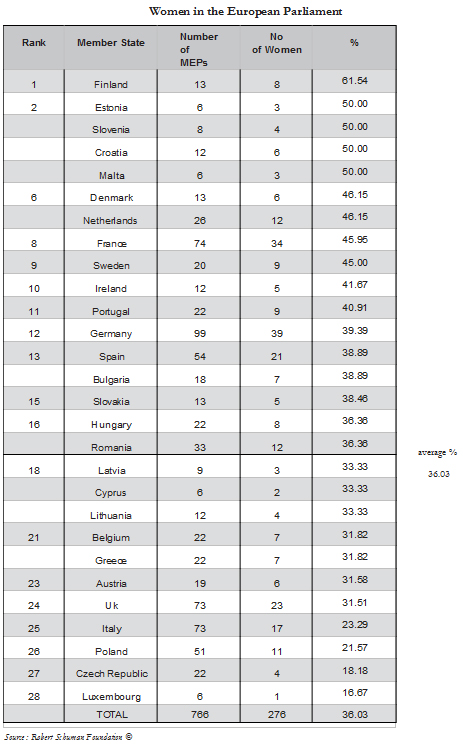
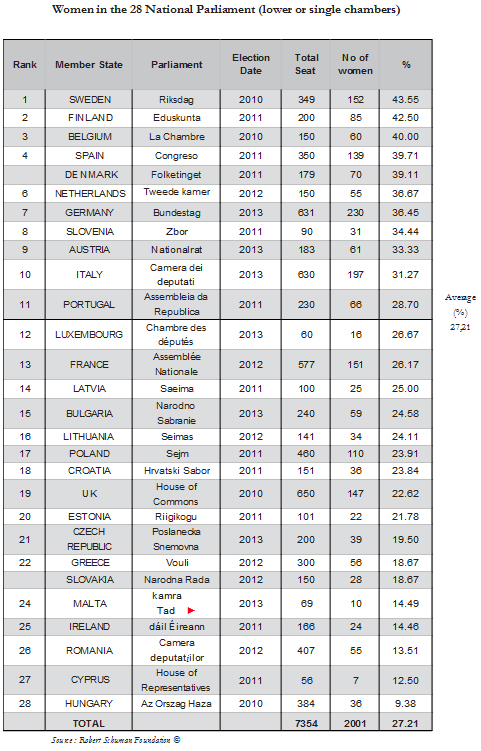
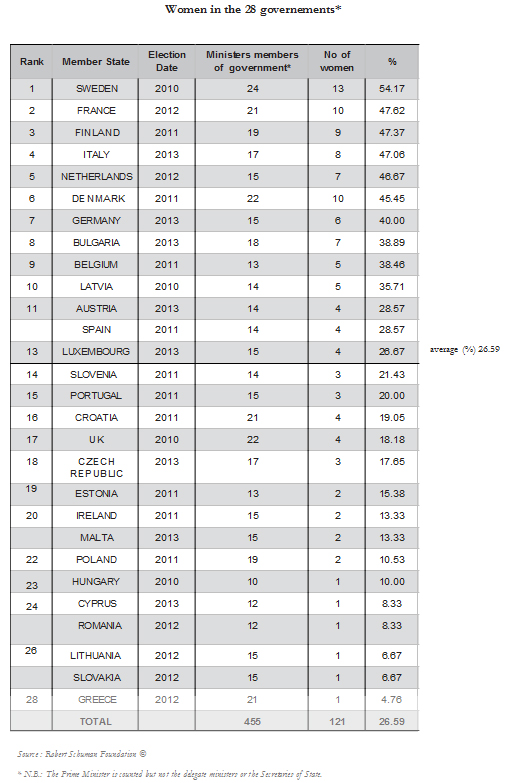
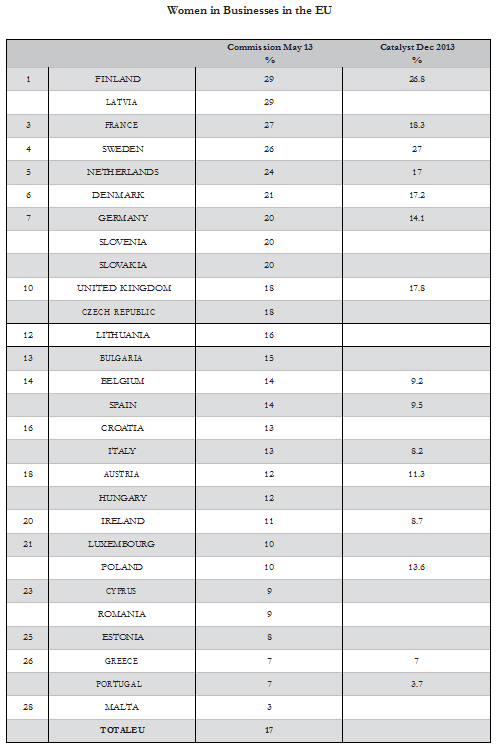
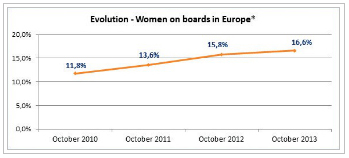
Publishing Director : Pascale Joannin
On the same theme
To go further
Freedom, security and justice
Jean Mafart
—
15 April 2025
Asia and the Indo-Pacific
Pierrick Bouffaron
—
8 April 2025
Democracy and citizenship
Radovan Gura
—
25 March 2025
Strategy, Security and Defence
Stéphane Beemelmans
—
18 March 2025

The Letter
Schuman
European news of the week
Unique in its genre, with its 200,000 subscribers and its editions in 6 languages (French, English, German, Spanish, Polish and Ukrainian), it has brought to you, for 15 years, a summary of European news, more needed now than ever
Versions :




